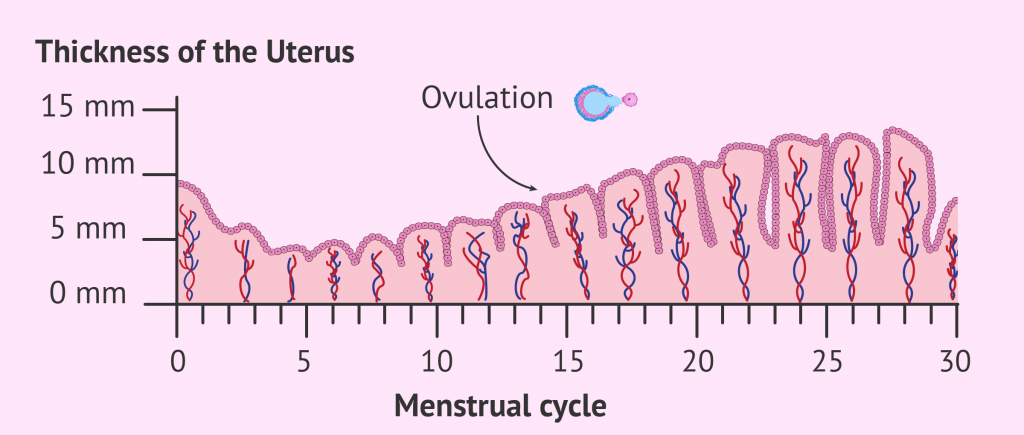A woman’s body is wondrous. And, when it comes to the reproductive anatomy, the structure not just gives birth to new life, it undergoes consistent changes every month. Amidst all the parts, the endometrium is a standout part of the anatomy. It undergoes size changes every month during a woman’s fertile years.
The endometrial thickness varies during the monthly menstrual cycles. It either increases or decreases during the process. The interaction of hormones like estrogen and progesterone are responsible for the integrating changes to the endometrial lining in the uterus.
This article will discuss normal endometrial thickness, what instigates changes, and when it becomes a matter of concern.
Also Read: Bilateral Polycystic Ovaries: What Does It Mean in Ultrasound Abdomen Scan Report for PCOS
In this Article
- 1 What is the Normal Thickness of Endometrium?
- 2 How is the Endometrium Size Measured?
- 3 What Results in Changes to Endometrium Anatomy?
- 4 When Should One See a doctor?
- 5 Conclusion
- 6 FAQs
- 6.1 1. Why is the endometrial thickness high?
- 6.2 2. What happens if the endometrial thickness is 20 mm?
- 6.3 3. Does high endometrial thickness mean cancer?
- 6.4 4. How many mm should endometrium be for pregnancy?
- 6.5 5. Can I get pregnant with 12 mm endometrial thickness?
- 6.6 6. How is endometrial thickness measured?
Get a consultation with the best specialist in your Location
What is the Normal Thickness of Endometrium?
As we said before, the size of the endometrium undergoes consistent changes throughout one’s fertile years. During different menstrual cycle stages, the endometrium either increases or decreases in size every month.
Also Read: Women with Undiagnosed Endometriosis Face Difficulty in Getting Pregnant, Research Says
Even after the fertile years, the endometrium changes in size due to the impacts of menopause.
Typically, the endometrium is the thinnest during menstruation. It then gradually increases in size during the proliferative stages and later. Remember that the hormones during the menstrual cycle instigate the growth and depletion of the endometrial lining during different stages of the cycle.
Let us break down the normal size of the endometrium during different menstrual cycle stages in a month.
| Stage | Size |
| Normal Endometrial Size | Less than 14 mm is medically considered normal. |
| During Menstruation | Pre-menopausal women have an endometrial thickness between 2-4 mm. |
| Early Proliferative Stage | Ranges between 5-7 mm. Happens 4-5 days after menstruation. |
| Late Proliferative Stage | Ranges between 10-11 mm. Lasts between 11-14 days where the glands form a packed structure. |
| Luteal Stage | Ranges between 12-13 mm. Lasts between 14-28 days of the menstrual cycle. |
| Post-menopausal women | Without hormone therapy – less than 5 mm
With hormone therapy – up to 15 mm |
Having the correct endometrial lining is crucial for a successful pregnancy. Not only does it regulate one’s fertility, but a healthy-sized endometrium also regulates the monthly menstrual cycles in the body.
A healthy and normal-sized endometrium ensures optimal implantation of the embryo. This further ensures healthy growth and multiplication of the mature embryo and optimal nutrition supply.
An endometrial thickness between 4-6 mm is ideal for a healthy full-term pregnancy.
How is the Endometrium Size Measured?
Ultrasound imaging helps measure the endometrial thickness. This helps gauge the status and health of the endometrium, ensuring that it’s not too thin or thick for the healthy implantation of the embryo.
However, in cases of an inverted uterus or other medical anomalies where ultrasound imaging is not possible, doctors resort to other imaging technologies like MRI.
What Results in Changes to Endometrium Anatomy?
Any drastic changes to the endometrium in the uterus will affect a woman’s fertility and regulation of the menstrual cycle. It is not just during the menstrual cycle that the endometrium changes. Ideally, the changes can be relayed due to other external factors.
Ideally, the chances of endometrial thickening or endometrial hyperplasia are more common can thinning. The exceeded levels of estrogen in the bloodstream contribute to the thickening.
On the flip side, endometrial thinning is also a medical concern that affects 5% of women under 40 and 25% over 40 years.
Some of the common causes behind these issues include:
| Causes of Endometrial Thickening and Thinning | |
| Thickening (Endometrial Hyperplasia) | Thinning |
| Ectopic pregnancy | Menopause |
| Endometrial cancer, Ovarian cancer | Inflammation |
| Obesity | The consequence of other treatments |
| Undergoing hormone replacement therapy | Uterine abnormalities |
| Chronic hypertension | Post-surgical complications |
| Development of endometrial polyps | Malnutrition |
| Diabetes | Side effects from birth control pills |
| Adherence of scar tissue | Anatomical issues of the uterus |
When Should One See a doctor?
The changes to the size of the endometrium are common in women worldwide. However, you need to realize that the diagnosis of endometrial abnormalities doesn’t happen until one faces issues with their periods or during conception.
However, any abnormalities with the menstrual cycle every month are a sign that you need to see a doctor immediately. Abnormal vaginal bleeding is the first red flag that demands immediate medical attention.
Besides that, the following are some of the instances you need to seek medical help:
- Witnessing spotting during periods
- Not getting periods for months
- Unusually heavy vaginal bleeding during menstruation
- Vaginal bleeding after menopause
If you notice any of these symptoms, along with unexplained pelvic pain, it is ideal that you see a doctor immediately. Early evaluation rules out severe conditions like endometriosis, polyps, cysts, and even endometrial cancer.
Get a consultation from the best IVF center of your Location
Conclusion
Being mindful of one’s endometrial thickness is a necessity, especially if you want to have a comfortable and healthy full-term pregnancy in the future. While it is true that the endometrium undergoes rapid changes throughout one’s lifespan, it is also true that you need to look out for abnormalities.
If taken for granted or left untreated, these signs and symptoms can blow up and lead to unexplained severities like uterine cancer. Early diagnosis and proper treatment can help lead a healthy, fertile, and content life.
FAQs
1. Why is the endometrial thickness high?
Also known as endometrial hyperplasia, the excess thickness in the endometrial lining of the uterus generally results from excess cell accumulation. The condition generally happens due to excess estrogen secretion in the blood. Also, low progesterone levels contribute to the thickness. Marked hormonal imbalance in the body is generally considered to be the pivotal cause.
2. What happens if the endometrial thickness is 20 mm?
The normal thickness of the endometrium in a healthy female is less than 5mm. The uterus generally goes up to 20mm (maximum) in thickness during the secretory phase. So, a transvaginal imaging showcasing a thickness of 20mm and above generally indicates a possible risk of endometrial cancer. Further testing is required to confirm a diagnosis.
3. Does high endometrial thickness mean cancer?
High endometrial thickness is marked by excess accumulation of cells in the endometrium. Although it doesn’t always indicate possibilities of cancer, a higher thickness can enhance the risk of uterine cancer in some women. If the thickening is paired with abnormalities in extra-lining cells, it could indicate risks of uterine cancer. Your doctor will prescribe more thorough imaging and blood work to reach a conclusion.
4. How many mm should endometrium be for pregnancy?
When it comes to a healthy, ideal, and low-risk pregnancy, the maximum measurement of a healthy endometrium is generally considered at a threshold of 10 mm or more to contribute to the live births of newborns with reduced risks of pregnancy loss.
5. Can I get pregnant with 12 mm endometrial thickness?
Studies indicate that women have a heightened chance of getting pregnant with an endometrial thickness of 8 mm to 11 mm in the endometrial thickness chart, which can drastically reduce if the thickness cross 14 mm. The age of an individual also plays a key role in the process.
6. How is endometrial thickness measured?
Since the endometrium is a female reproductive organ, the most efficient and common way to measure an endometrium is by using an ultrasound. Not only does it measure the thickness, but it also checks the health of the uterine lining and the associated organs in the vicinity.





